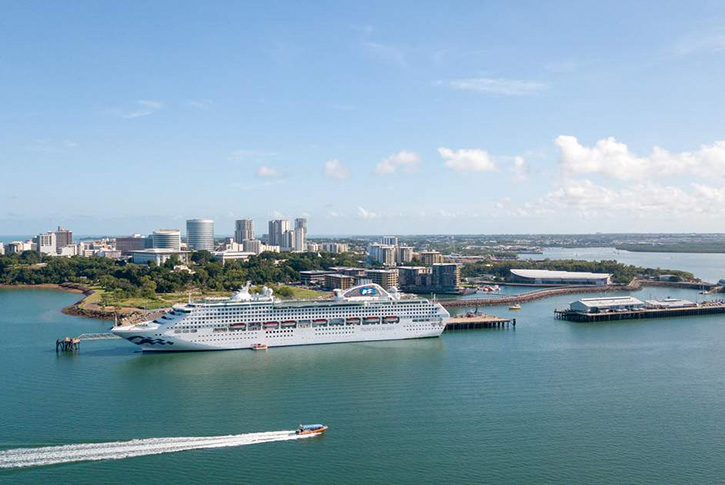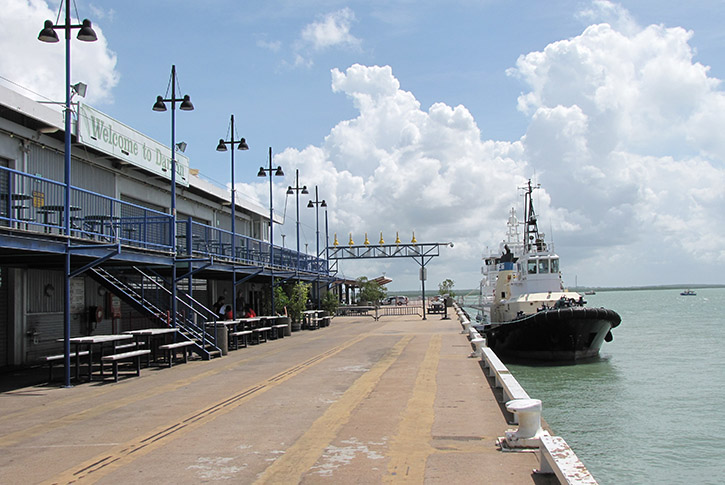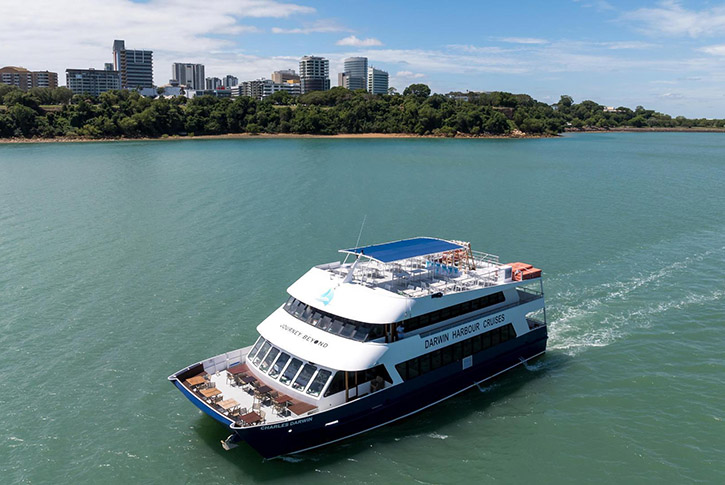Darwin Harbour Odyssey: Where History, Scenery, and Vessels Converge
- by Filip

1. Arriving in the Northern Frontier
The descent into Darwin had the usual stir of excitement that comes with arriving somewhere far from the familiar. The moment the aircraft’s wheels touched down, I felt it — that subtle pulse of heat rising off the tarmac, the dry clarity of the air tinged with brine, and the sunlight that feels just a shade more honest than elsewhere. Darwin has always intrigued me, and this visit was long overdue. Unlike Australia’s bustling southern cities, Darwin stretches out with a confidence born of resilience, shaped by cyclone winds, warfronts, and tides both literal and historical.
After collecting my bags and stepping out into the sunlight, I made my way toward the waterfront. That’s where everything begins and ends in Darwin — at the harbour.
2. Tracing the Shoreline: First Glimpses of Darwin Harbour
From the Esplanade, the view opens wide. Darwin Harbour isn’t just a port — it’s a panorama, a theater, a historical witness. The skyline is modest, defined more by sky than by steel, and in its foreground lies a vast, shimmering expanse of blue. Boats drift like punctuation marks against the horizon, and the land curves in elegant defiance of modern urban planning.
The water is almost unnaturally calm in the mornings. It mirrors the sky with reverence, broken only by the wakes of catamarans and the occasional fishing vessel heading out. I paused often along the Bicentennial Park, listening to birdsong and the occasional clang of distant boat rigging. Every bench along the path seems perfectly placed for a moment of silent contemplation.
I was eager to get closer — not just to see the harbour, but to feel it, to ride it, to walk beside it where history whispered from old stone and rusted moorings.
3. Stokes Hill Wharf: Where the Old Meets the Tide

Stokes Hill Wharf is a working memory. There’s a sturdiness to it, with timbers worn by decades of footsteps and tides. But it’s more than infrastructure — it’s narrative.
The wharf’s name harks back to the survey expeditions of the 1830s, with Captain John Clements Wickham naming the nearby hill after his colleague, Lieutenant Stokes. Today, that same stretch of wharf welcomes tourists, fishers, and seagulls in equal measure. It has known the hush of waiting ships and the roar of wartime bombardments.
I strolled its length slowly, letting the sun warm my shoulders. Along the edges, people sat with rods dangling over the sides, watching the water like they were waiting for an old friend. There’s a rhythm to the place. Between the seafood eateries and the WWII Oil Storage Tunnels nestled nearby, the past lives comfortably beside the present.
A local older gentleman — white beard, well-worn Akubra — sat gutting a fish near the edge. He nodded at me without breaking rhythm. “The harbour’s been here longer than any of us,” he said, without being asked. “She remembers everything.”
4. Aboard the Charles Darwin: Cruising into Twilight
No experience on Darwin Harbour would be complete without seeing it from the water. Boarding the Charles Darwin, a double-decked cruise vessel with generous viewing decks, felt like stepping into a moving gallery.
As the boat pulled away from the mooring, the city fell into perspective. Low-rise buildings painted in hues of sun and sandstone receded as mangroves and coves claimed the foreground. The guide’s voice, gentle and informative, narrated the geography and history. Below us, crocodiles sometimes lurk, though none made an appearance that evening.
The real magic unfolded as twilight approached. The sun dropped slowly toward the western edge of the harbour, and the sky blazed orange, then crimson, then bruised violet. Reflections danced on the water in slow motion. Cameras clicked all around me, but I didn’t feel the need. Some things imprint better on memory than on pixels.
Upstairs on the top deck, I sipped a cool drink and watched as Fort Hill rose into view on the starboard side. Long before the city was built, this was a lookout point, then later a defence post. The old and the natural intertwine seamlessly here.
5. The Forgotten Defenders: Wartime Echoes of Darwin Harbour
Beneath the tranquil surface of Darwin Harbour lies a theatre of war. On 19 February 1942, the Japanese launched two air raids on the city — the largest attack on Australia by a foreign power. Ships were bombed, buildings destroyed, lives lost. The harbour roared with chaos that day, a stark contrast to its current calm.
I visited the Darwin Military Museum earlier that day, where an entire section is devoted to the harbour’s wartime role. Looking out from the boat now, it was hard to reconcile the peace with the violence it once witnessed. But perhaps that’s part of its character — not to forget, but to carry on with grace.
The remains of sunken ships still rest on the seabed, and divers sometimes seek them out. On certain days, when the tide is especially low, parts of the wreckage reveal themselves like ghosts seeking air.
6. Cullen Bay Marina: The Modern Harbour Lifestyle
Just around the headland, Cullen Bay offers a more polished harbour experience. Here, the marina is lined with upscale residences, chic restaurants, and leisure yachts bobbing gently in their berths. But the harbour, ever loyal to its essence, still whispers through the masts.
I wandered past waterfront cafes, the aroma of grilled seafood floating on the breeze. Pelicans coasted overhead. Kids darted along the boardwalk with ice creams melting in hand. It felt like a postcard scene — yet rooted in something deeper than gloss.
From a corner of the marina, I spotted a local artist sketching the view. Her strokes were deliberate, her expression focused. She caught my eye and smiled. “The light’s always changing here,” she said, without putting down her pencil. “You could draw this same scene a hundred times and never get it the same twice.”
7. Larrakia Land: Harbour of Ancient Custodianship

Long before European ships charted these waters, the Larrakia people stood here, facing the tides with generations of wisdom behind them. Darwin Harbour — or Gulumoerrgin in Larrakia language — was a source of life, food, and connection.
In one of the cultural walking tours I joined, the guide spoke not only of colonial history, but of ancestral links to the harbour. Mangroves became medicine cabinets. Mudflats were pantries. The tides were timekeepers.
At a bend in the path near East Point, he pointed to a cluster of trees. “That’s where the elders would sit,” he said. “And from there, you could see the sea and know what kind of day it would be.” That awareness — of being part of the harbour rather than standing beside it — stayed with me.
8. Low Tide Walks and the Secrets Beneath
One morning, I woke early to catch the harbour at its lowest tide. The moon had pulled back the sea like a curtain, revealing a sandy, rippled stage below. I walked barefoot across the exposed flats near Nightcliff, dodging tiny crabs and half-buried shells.
The harbour receded in quiet majesty, but it left gifts in its wake — driftwood polished by time, seaweed tangles hiding minute treasures, and pools where starfish waited out the sun. The texture of the land was suddenly visible, its hidden anatomy made bare for just a few hours.
A child nearby pointed at something in the sand and shouted with glee. His mother laughed and leaned over to examine it. The harbour does this — it gathers people into moments that feel effortless and lasting.
9. Sunset from East Point Reserve
Another evening, I found myself at East Point Reserve. Here, the harbour curves outward into the Timor Sea, and the sunsets feel endless. Locals arrived with picnic baskets and folding chairs. Some brought wine, others brought guitars.
I found a quiet spot along the edge and watched as the light softened the sea’s surface into liquid gold. The horizon seemed closer here. Ships in the distance looked like cutouts against the fire-tinged sky. No one rushed. No one spoke too loudly.
When the sun finally dropped below the line, there was a collective hush — that breathless pause that only comes with natural beauty in real time.
10. A Place That Carries Itself
Harbours often serve as thresholds — places between departure and arrival. Darwin Harbour, though, is more than a transit point. It holds its stories deep and shares them without fanfare. One just has to look long enough, listen closely enough.
Over the days, I traced its edges, rode its surface, and walked where its waters once covered. I heard laughter on its wharves and silence in its mangroves. I saw where bombs once fell and where children now splash. All of it part of the same unbroken narrative.
Even after leaving the waterfront and retreating into the city’s quiet streets, the harbour remains close — a breath away, a memory lingering like salt on the skin.
1. Arriving in the Northern Frontier The descent into Darwin had the usual stir of excitement that comes with arriving somewhere far from the familiar. The moment the aircraft’s wheels touched down, I felt it — that subtle pulse of heat rising off the tarmac, the dry clarity of the air tinged with brine, and…
Recent Posts
- Darwin Harbour Odyssey: Where History, Scenery, and Vessels Converge
- Flying from Cairns to Darwin: Flight Time, Cost, and Booking Tips
- Cairns Family-Friendly Hotel: A Perfect Stay for the Whole Family
- Classic Australian BBQ Restaurants in Cairns: Indulging in Delicious Steaks
- Cairns One-Day Itinerary: Great Barrier Reef, Rainforest, and Tropical Beaches